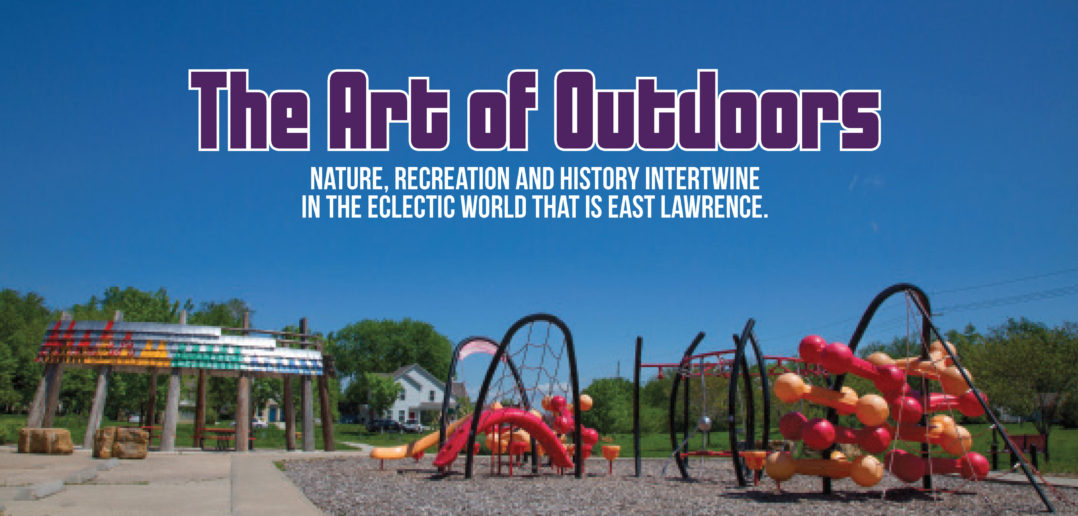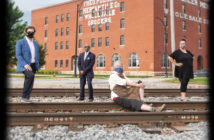| story by | |
| photos by | Steven Hertzog |
Nature, recreation and history intertwine in the eclectic world that is East Lawrence.
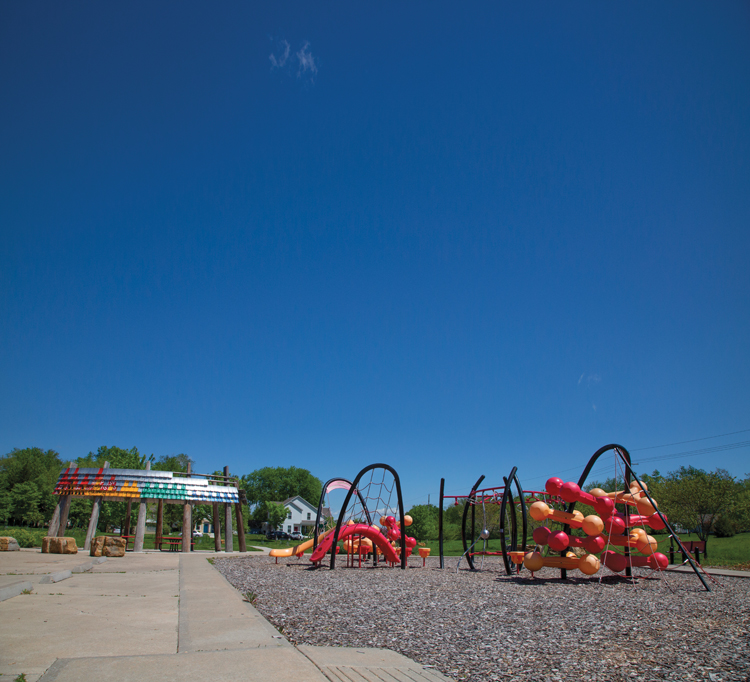
Along the Kaw Pavilion at Burroughs Creek Trail
Spending time outdoors is an essential part of life, especially during times of increased daily stress and anxiety. According to WebMD, the health benefits of spending time outside include getting exercise and Vitamin D (vital for your bones, blood cells and immune system), decreasing anxiety, connecting with others, improved sleep, increased self-esteem, sharper focus, better immunity, a boost in creativity and maintaining a healthy weight.
“Access to recreation is essential for people of all ages and all walks of life,” explains Stephen Mason, recreation center programmer for the City of Lawrence Parks and Recreation department. “From children learning social skills and coordination through sports, to adults maintaining a healthy lifestyle and managing stress, to seniors learning new skills and maintaining social cohesion, recreation improves everyone’s life.”
So how do you improve your life through recreation during a worldwide pandemic when you’ve been relegated to your house and told to leave only for essential goods such as groceries?
“We are a community of people who like to have house concerts, potlucks, socialize with each other, and we cannot do that,” explains Barry Shalinsky, board member and former president of the East Lawrence Neighborhood Association (ELNA). Right now, “People walk and bicycle and garden, perhaps a bit more than normal. People are pretty observant of social distancing. Though people use parks and trails, they do not congregate, and people speak from a safe distance.”
But once our world finally settles down and gets back to normal (or possibly a new normal post-pandemic), it’ll once again be time to explore the world around you. So why not start with East Lawrence?
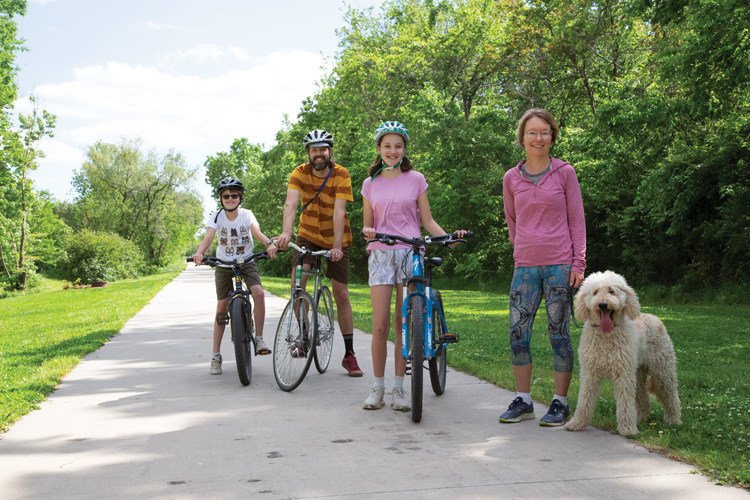
Kristi St. Onge and her family spend time on the trail.
Uniquely ELaw
Since its early beginnings, East Lawrence has been a diverse working-class neighborhood built on a walkable scale, Shalinsky says.
 Many of the green places and open spaces that need protecting most today are in our own neighborhoods. In too many places, the beauty of local vistas has been degraded by decades of ill-planned and ill-coordinated development.
Many of the green places and open spaces that need protecting most today are in our own neighborhoods. In too many places, the beauty of local vistas has been degraded by decades of ill-planned and ill-coordinated development. 
–Al Gore
He explains the ELNA gives an organized voice to East Lawrence residents and works to preserve the character of the neighborhood, supporting infrastructure enhancement, preservation of brick sidewalks and streets, right-of-way tree planting, rezonings to preserve residential character of the neighborhood, cleanups, services for residents and social gatherings among community members. It works with the city offering input on municipal decisions that potentially impact the neighborhood.
“Lawrencians should definitely visit East Lawrence facilities for unique attributes such as kickball games in Hobbs Park, cultural events … bicycling or jogging on the Burroughs Trail,” Shalinsky says. “Reading the kiosks on the trail can be an educational experience. On the way there, Lawrencians should notice the neighborhood’s special charm.”
That “special charm” is abundant in the east side’s outdoor and recreational offerings.
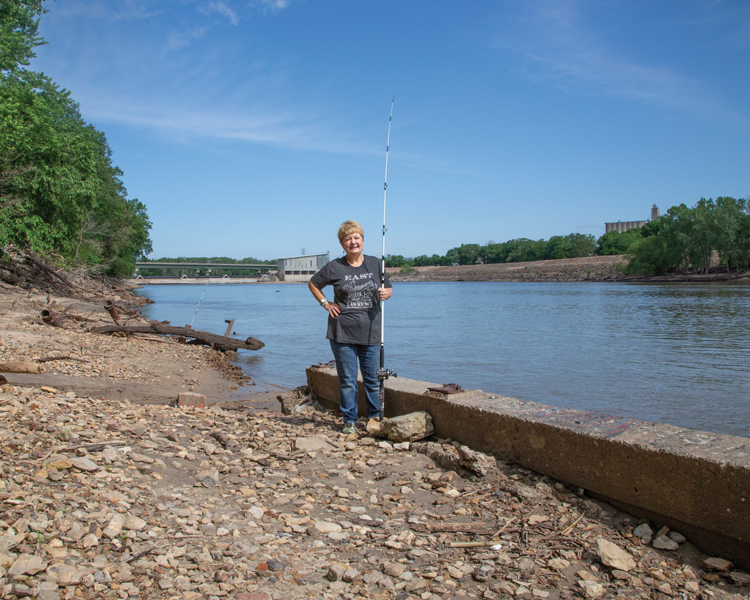
KT Walsh fishes in east Lawrence
Burroughs Creek Trail and Linear Park
A popular spot for walking, running, biking or just enjoying some time in nature, Burroughs Creek Trail and Linear Park runs from 11th to 23rd streets along an abandoned rail corridor west of Haskell Avenue. Funded through a sales tax passed by voters in November 2008 along with a KDOT transportation grant, the initial purpose of the trail was “to provide a safe walking and biking path for the neighborhood, as well as continued development of the Lawrence Loop, which had this trail connect to the Haskell Rail Trail,” the first operational rail-trail in Kansas, explains Roger Steinbrock, marketing coordinator with the Parks and Recreation department.
“That’s what public or community parks and facilities are meant to do—bring people together as a community,” he continues. “Physical activity is important to one’s well-being. Parks and trails allow people to relieve stress, get back to nature as well as be physically active.”
Kristi St. Onge, engineer and resident of East Lawrence, agrees. “We are always on the move, so a connecting park is our favorite kind,” she says. “It is a nice, wide trail with workout stations that the kids enjoy and informational signs that tell the history of the area.”
She explains her family often uses the Burroughs Trail to get to downtown or to the Baker Wetlands, both favorite spots of theirs. “You can even get to Fields and Ivy Brewery,” she quips. “It’s unique and useful at the same time.”
A notable addition to the park in 2019, The Kaw Pavilion won the global 2019 Architecture Master Prize competition, one of just eight awards presented in the “Green Architecture” student category. The project also won the American Institute of Architects Merit Award in the professional category for Small Architectural Project. Built in collaboration with the University of Kansas School of Architecture and Design third-year students and the City’s Parks and Recreation department, the project was praised for its unique design, use of recycled and sustainable materials, and expansive community and professional partnerships. It’s named for the Kansas River, the watershed in which it resides, and draws inspiration from the Kansa tribe, the first inhabitants of the region.
Located at 900 E. 15th St., the structure is used as an outdoor classroom, meeting space for local groups, as well as a resting area for trail users.
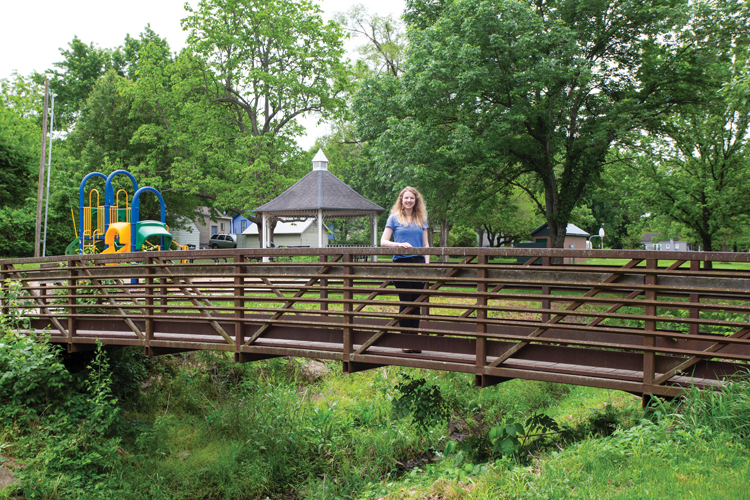
Amy Ousdahl on the bridge in Brook Creek Park
Brook Creek Park
Possibly one of the most historical outdoor spaces in East Lawrence, in the early 1900s, Brook Creek Park was one of the very first amusement parks in the country. Known then as Woodland Park, the 43 acres of woods between the northernmost residences of Brook Creek Neighborhood, the Public Works Yard and the Burlington Northern Santa Fe (BNSF) Railroad tracks was the site initially purchased by the Lawrence Amusement Co., which built the amusement park.
In his very first novel “Not Without Laughter,” Langston Hughes writes: “The first of its kind in the city, with a merry-go-round, a shoot-the-shoots, a Ferris wheel, a dance-hall, and a bandstand for weekend concerts.”
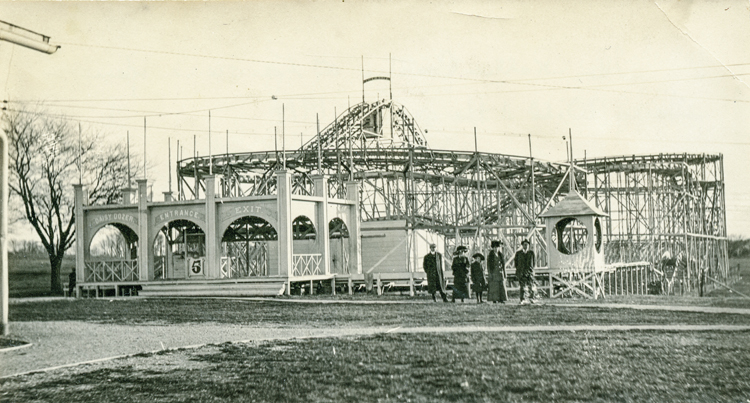
The Daisy Dozer rollercoaster at Woodlawn Park in east Lawrence. Douglas County Historical Society, Watkins Museum of History.
Just 25 years after Coney Island opened the very first roller-coaster in the country, the “Daisy Dozer” was constructed in Woodland Park. According to the 2010 Lawrence Journal-World article “The Daisy Dozer’s Day,” in June of 1910, the Lawrence Amusement Co. constructed the Daisy Dozer roller-coaster in the park, which was close to heavy rail lines. This drew traveling carnivals, circuses with exotic animals and celebrities like Buffalo Bill and his Wild West Show to Woodland Park. Added later were a half-mile horse-racing track, a baseball diamond, a football field and a large dance pavilion with a stage.
According to the Lawrence Daily-World Journal on Dec. 23, 1913: “The city enjoys a modern pleasure grounds, where old and young have been enabled to spend a day or evening under favorable weather conditions, without interference from an undesirable element. The attendance proved the popularity of Woodland Park.”
Amy Ousdahl, Brook Creek Neighborhood Association (BCNA) coordinator, says that in the late 1920s or early 1930s, the amusement park fell into disrepair, and the land was offered to the city for free if it were to remain a park. Because the city wanted to use it for industrial purposes, the offer was turned down. A stalemate ensued that lasted for years, and finally the city purchased the land and agreed with the BCNA that the “Nature Woods Area” would remain an undeveloped wooded nature preserve.
In 2017, BCNA, along with Grassland Heritage Foundation and Kaw Valley Native Plant Coalition, installed a new perennial native plant garden in Brook Creek Park. Located on the west side of the park gazebo, Ousdahl explains, prairie plants such as butterfly milkweed, upright coneflower, Bush’s poppy mallow, New England aster, Missouri evening primrose and prairie dropseed grass develop very deep roots to help native plants survive dry conditions and prevent soil erosion. This also provides habitat for indigenous wildlife.
“Brook Creek is traditionally a gardening neighborhood, and many of our residents use their yards as food garden space,” she says. “So there is an emphasis on preserving green spaces throughout our community.”
Tucked back in nature away from busy main roads, the park offers visitors a place to enjoy traditional playground offerings (play equipment, basketball courts, gazebo, restrooms), along with access to the nature woods area trails and nature preserve.
“Brook Creek Park is a hidden gem in the neighborhood parks system and is a great spot to stop if you’re in the area visiting Oak Hill Cemetery or Memorial Park Cemetery,” Ousdahl says, “or just looking for a quiet, family-friendly park.”
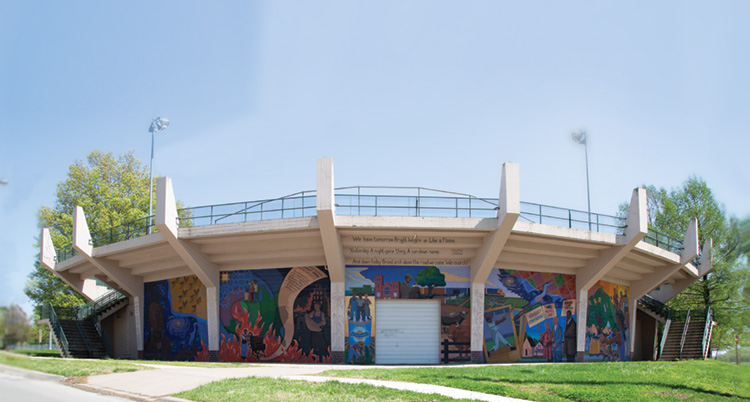
The Dave Loewenstein mural adorns the stands at Hobbs Park.
Hobbs Park
Myra Hobbs, a late resident of Lawrence, left in her will approximately $70,000 to the City of Lawrence to be used to purchase land to create a city park. She directed the City to purchase land existing east of Massachusetts Street between Sixth and 15th streets, and asked the park be named for her late husband, Earl Hobbs.
KT Walsh, East Lawrence Neighborhood Association vice president, recites the story she heard: Hobbs donated the money so the children of East Lawrence could have a park, but the city took the money hoping to use it for the Haskell Loop, claiming there were no children in East Lawrence to build a park for. Local Reverend Wesley Sims and his wife, pivotal figures in East Lawrence history, told East Lawrence residents to dress their children in their Easter best, and he led them, along with local ministers, to City Hall. At the podium, the reverend asked everyone to join hands and pray. One commissioner pointed out they did not pray at commission meetings, but the reverend closed his eyes and led a prayer anyway. As the children were gathered around the reverend, he said, “These are the children of East Lawrence, and they deserve their park.”
“We got our park,” Walsh quips.
Located at 10th and Delaware streets, Hobbs Park has three distinct elements, ELNA board member Shalinsky points out. The historic Municipal Stadium structure and ball field were previously used for baseball and softball, and now hosts the Kaw Valley Kickball League, a nonprofit community organization that raises money for local nonprofits. Sunday nights at the ball field have been happening for well over 40 years. The playground and picnic area are the “neighborhood” part of the park, used primarily by East Lawrence residents. And the Murphy-Bromelsick House, an 1860s house relocated to the park in 2001, serves as a reminder of the city’s abolitionist history.
“This is one place where communities define, experience and celebrate themselves,” Shalinsky says. “There is no finer example of this than the Stadium mural art.”
There have been improvements to the park over the years, Walsh says, and the ball stadium is now on the local and state historic registers because of the Negro League and semipro games that were played regularly there, as well as for its architecture.
“Since East Lawrence is part of the original townsite and densely inhabited, with 50-foot-wide lots, Hobbs Park is small,” Walsh continues. “We would love to see it expanded east where the old sale barn was. Most parks in the newer parts of town are larger because the open land was there. Once again, our kids deserve a bigger park.”
Along with Municipal Stadium and the playground area, Hobbs also offers a picnic shelter (with electricity, barbecue grill, picnic tables, a drinking fountain), basketball court and a baseball/softball field.
“When the fireflies return in summer, the park becomes a magical, sparkling place,” Walsh says.

Stephen Mason in front of East Lawrence Recreation Center
East Lawrence Rec Center
If you prefer a facility that offers both indoor and outdoor options, the East Lawrence Recreation Center, built in 1979 in the heart of the historic east side, is popular among people young and old, and provides a comfortable atmosphere to work out, play games, take classes, hold meetings, play on the playground or just enjoy locally created mosaics and sculptures. Located at 1245 E. 15th St., the center is a hub of activity on most days and a popular place for local east-siders.
The facility went through a $2-million renovation in 1997, funded by a one-cent sales tax passed in 1994, part of which was used for the original art both inside and outside the facility.
“We are one of the truly neighborhood recreation centers,” Rec Center programmer Mason says. “We work to cultivate relationships with the people who come through the building. In my time here, I’ve gotten to be a part of one young man’s incredible weight-loss journey, seen troubled kids blossom and graduate, and coordinated with generous patrons who have donated a piano, soccer goals and some of our game equipment.”
The Rec Center strives to serve all groups and create a safe and welcoming space for everyone to recreate in their own way, he continues. Some groups come to walk laps in the morning and have coffee afterward; there’s a special populations camp in summer and wheelchair basketball in the winter; and kids can be found running around as early as 7:30 a.m. some mornings.
The East Lawrence community is “passionate, supportive and kind. They help each other with skills in the gym and share the communal space well. They look out for children in the neighborhood and help each other whenever they can,” Mason says.
The Rec Center is free and open to the public, and it rents space for private events. It has a gym, locker and shower facilities, small gym for gymnastics (which includes a tumble track, bars, rings, rope, balance beam, minitrampoline, cheese wedge, octagons and preschool mats), wellness and weight room, and a meeting room with a full-sized kitchen.
New Beginnings
Whether you live on the north, south, east or west side of Lawrence, the history, beauty and uniqueness of East Lawrence are always great to explore. And during times of change and uncertainty, getting outdoors can provide a sense of peace and stability.
It is “a community of creative, talented, free-thinking individuals. We love and are proud of our neighborhood, our built environment, our history, our neighbors,” ELNA’s Shalinsky says. “Because of our neighborhood’s age and location, and attendant redevelopment pressures, we live in a fragile balance. We are passionate about protecting our neighborhood and our neighbors. We love to celebrate ourselves together in our outdoor spaces.”

